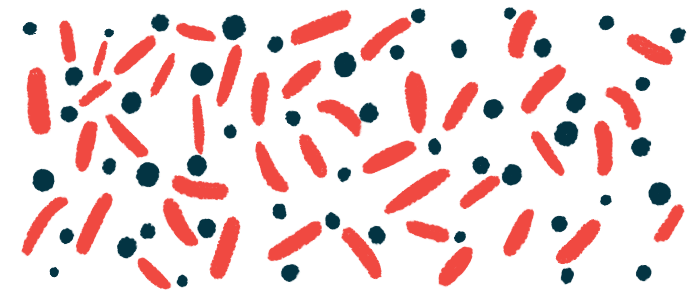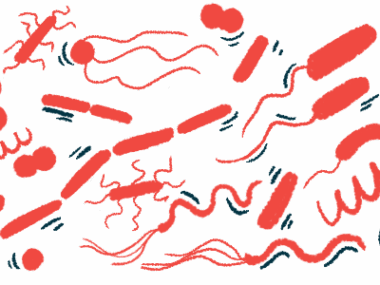MS Therapy Boosts Tobramycin’s Effectiveness Against P. aeruginosa
Written by |

Glatiramer acetate, an approved multiple sclerosis (MS) therapy, improved the effectiveness of the antibiotic tobramycin against Pseudomonas aeruginosa, a type of bacteria that commonly infects the lungs of people with cystic fibrosis (CF), a study demonstrated.
The findings support glatiramer acetate as a promising antibiotic add-on therapy candidate, although more work is needed to formulate delivering it to the lungs of CF patients, the researchers recommended.
The study, “Synergistic Activity of Repurposed Peptide Drug Glatiramer Acetate with Tobramycin against Cystic Fibrosis Pseudomonas aeruginosa,” was published in Microbiology Spectrum.
CF is marked by the buildup of thick mucus in the lungs, increasing the risk of infections, particularly by P. aeruginosa. In the U.K., about 40% of adults with CF are chronically infected with the bacteria, a concern because of its ability to resist antibiotic treatments.
Tobramycin is a broad-spectrum antibiotic commonly used to treat P. aeruginosa. It’s administered either into the vein or inhaled directly to the airway. Once an infection is chronic, the effectiveness of antibiotics such as tobramycin is moderate, and their ability to eradicate it is rare, however.
Repurposing approved therapies with well-established safety profiles as antibiotic add-on treatments is a potential strategy to combat treatment-resistant bacteria.
Glatiramer acetate (GA), marketed as Copaxone and also available as a generic medicine, is an immunomodulator approved to treat MS, a neurodegenerative condition caused by the immune system mistakenly attacking the protective coating around nerve fibers. GA has been shown recently to have moderate activity against P. aeruginosa.
Researchers at the Imperial College London, U.K. tested GA’s ability to enhance tobramycin’s effectiveness against strains of P. aeruginosa.
Three P. aeruginosa reference strains (PAO1, PA14, and PAK) were tested against a wide range of tobramycin concentrations with and without GA.
No strain was suppressed by GA alone, while against tobramycin alone, PAO1 was the most susceptible and PAK was the least. In comparison, when GA and tobramycin were combined, the growth rate of PA01 and PAK was significantly lower and PK14 was nonsignificantly lower.
These findings were replicated by counting bacteria colonies. Fewer colonies after treatment means fewer surviving bacteria. The researchers noted that, combined with GA, “a significant impact was observed over a greater range of [tobramycin] concentrations” compared to growth rate measurements.
The team then confirmed that the impact of GA with tobramycin on these P. aeruginosa stains was synergistic — the combined effect of both agents was greater than the effects with GA and tobramycin alone.
To test clinical relevance, these experiments were repeated with 11 P. aeruginosa isolates collected from people with CF.
Across all isolates, GA significantly reduced the concentration of tobramycin needed to suppress bacterial growth by half (MIC50), from a median of 1.69 to 0.62 mg/L — a 2.7 times decrease. To suppress growth by 90% (MIC90), GA reduced the tobramycin required from 7.00 to 2.20 mg/L — a 1.7-times decrease.
Among the 11 isolates, six were found to be sensitive to tobramycin alone. Again, adding GA significantly reduced the concentration of tobramycin needed to suppress 90% bacterial growth, except in one isolate in which GA had no impact.
Against the remaining five isolates resistant to tobramycin, adding GA reduced tobramycin’s MIC50 and MIC90, although nonsignificantly. Regardless, for four of these tobramycin-resistant strains tested, combined treatment with GA reduced MIC50 to under 4 mg/L, “indicating these strains would be considered tobramycin-sensitive in the presence of GA,” the researchers wrote.
Lastly, the experiments demonstrated that GA worked by disrupting the outer and inner membranes of the bacteria, making the P. aeruginosa membrane more permeable, allowing more antibiotics inside the bacteria.
“While further work is also required to ensure the effectiveness of GA in the complex environment of CF sputum and to formulate delivery to people with cystic fibrosis, the confluence of antimicrobial activity, tobramycin synergy, and current clinical use makes GA a promising candidate for repurposing as an antibiotic adjuvant,” the researchers wrote.







